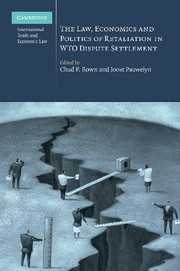Book contents
- Frontmatter
- Contents
- List of tables and figures
- Contributors
- Introduction: trade retaliation in WTO dispute settlement: a multi-disciplinary analysis
- PART I Background and goal(s) of WTO retaliation
- 1 The nature of WTO arbitrations on retaliation
- 2 The calculation and design of trade retaliation in context: what is the goal of suspending WTO obligations?
- 3 Extrapolating purpose from practice: rebalancing or inducing compliance
- PART II A legal assessment after ten arbitration disputes
- PART III An economic assessment after ten arbitration disputes
- PART IV The domestic politics and procedures for implementing trade retaliation
- PART V Problems and options for reform
- PART VI New frontiers and lessons from other fields
- Index
3 - Extrapolating purpose from practice: rebalancing or inducing compliance
Published online by Cambridge University Press: 26 February 2010
- Frontmatter
- Contents
- List of tables and figures
- Contributors
- Introduction: trade retaliation in WTO dispute settlement: a multi-disciplinary analysis
- PART I Background and goal(s) of WTO retaliation
- 1 The nature of WTO arbitrations on retaliation
- 2 The calculation and design of trade retaliation in context: what is the goal of suspending WTO obligations?
- 3 Extrapolating purpose from practice: rebalancing or inducing compliance
- PART II A legal assessment after ten arbitration disputes
- PART III An economic assessment after ten arbitration disputes
- PART IV The domestic politics and procedures for implementing trade retaliation
- PART V Problems and options for reform
- PART VI New frontiers and lessons from other fields
- Index
Summary
Scholars continue to debate over the aim of WTO remedies in light of the ambiguity of the legal texts. As Joost Pauwelyn writes, the goal of WTO remedies remains “murky and confused.” Some commentators contend that the overarching objective is, and should be, to induce compliance with WTO obligations. Others maintain that the central goal is, and should be, rebalancing – that is, to ensure that the overall balance of concessions is maintained. Rebalancing is to be achieved by permitting the successful complainant to suspend concessions in an equivalent amount. This chapter confronts the question inductively through an assessment of WTO members' practice.
One method of discerning purpose is by examining members' practice, constituting the law-in-action of WTO remedies. State practice implicates, at least in part, how WTO complainants view the primary objective of WTO remedies, and, in particular, whether they focus on rebalancing or compliance. This chapter's conclusions are supported by the five case studies in this volume regarding complainants' use of retaliation, respectively covering the United States, the European Union (EU), Mexico, Canada, Brazil, and other developing country members. Our conclusions are necessarily tentative given the few cases of authorized retaliation under Article 22 of the DSU (nine disputes involving eighteen nations in 13 years), and the even smaller number actually implemented.
- Type
- Chapter
- Information
- Publisher: Cambridge University PressPrint publication year: 2010
- 3
- Cited by

